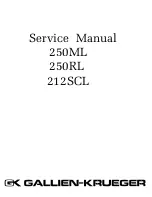
1
When designing an experiment using the Power Amplifier, consider the following:
1.
Input Signal
- The Power Amplifier requires an input signal source to
function; it does not create any waveforms without input. Most commonly it is
used with a LabQuest or with any AC or DC signal source that does not
exceed 12 V, such as the Function Generator (FGEN-PAMP). The Power
Amplifier provides both current and voltage gain so that larger loads can be
driven than is possible with the signal source alone.
2.
Output
- The output of the Power Amplifier can be connected to a speaker, a
test circuit such as an RLC circuit, or any device that requires a controlled AC
or DC signal.
3.
Current Sensor
- The current sense port allows monitoring of the current
through the output stage of the Power Amplifier. Connect this to a LabQuest
or other Vernier interface.
Using the Product
Connections on the Power Amplifirer
The Power Amplifier has several connectors used to control and monitor the
output.
l
3.5 mm Audio Port - The primary input is the 3.5 mm audio-style port on the
back panel.
l
BTA Port - The secondary input is the BTA receptacle on the back panel that
serves as both an input from LabPro and as a current sense output.
l
Red/Black Output Terminals - The two output terminals on the front panel are
used to connect the load circuit. The negative (black) terminal is connected to
ground via a 0.1 Ω resistor. The red terminal can range between ±10V.
The back of the Power Amplifier,
showing the Power Connector, the
Audio/LabQuest Connector, and the BTA
Connector
The front of the Power Amplifier,
showing the output terminals, the
Power Indicator LED, and the On/Off
Switch
Choosing an Input Signal for the Power Amplifier
The most common input signals for the Power Amplifier are a LabQuest or a
function generator. Other signal inputs to the Power Amplifier, including using a
LabPro, are described at
Power Amplifier
(Order Code PAMP)
With the Vernier Power Amplifier, you can drive loads
with ±10 V and currents up to 1 A. It works with any
input waveform, including DC, sine, square, triangle,
and sawtooth waveforms. The Power Amplifier can
drive a variety of loads, such as speakers, lamps, small DC motors, and RLC
circuits. These circuits typically draw more power than the signal source can
deliver. The Power Amplifier makes it possible to drive these heavy loads.
l
This sensor works with LabQuest
®
and with most function generators.
l
It can provide a steady, linearly controlled DC output for driving loads like DC
motors, and precise AC waveforms for driving things like speakers
l
Current is limited to protect against overload and shorting.
l
The current monitor function enables you to log real-time load current.
l
The class A-B Push-Pull Amplifier provides low distortion.
Note:
Vernier products are designed for educational use. Our products are not
designed nor are they recommended for any industrial, medical, or commercial
process such as life support, patient diagnosis, control of a manufacturing
process, or industrial testing of any kind.
What's Included
l
Power Amplifier
l
Power Supply
l
3.5 mm audio cable for LabQuest control
l
BTA cable for LabPro input and current sensing
Compatible Software
See
for a list of software compatible with the
Power Amplifier.
Getting Started
Some circuits require more current than can be delivered by the output of a
Vernier LabQuest or other signal sources. The Vernier Power Amplifier amplifies
an existing signal so that it can be used to drive a speaker, a coil, an RLC circuit, a
motor, a resistor for heating experiments, electrolysis apparatus or other
experimental apparatus. A list of suggested activities can be found at






















